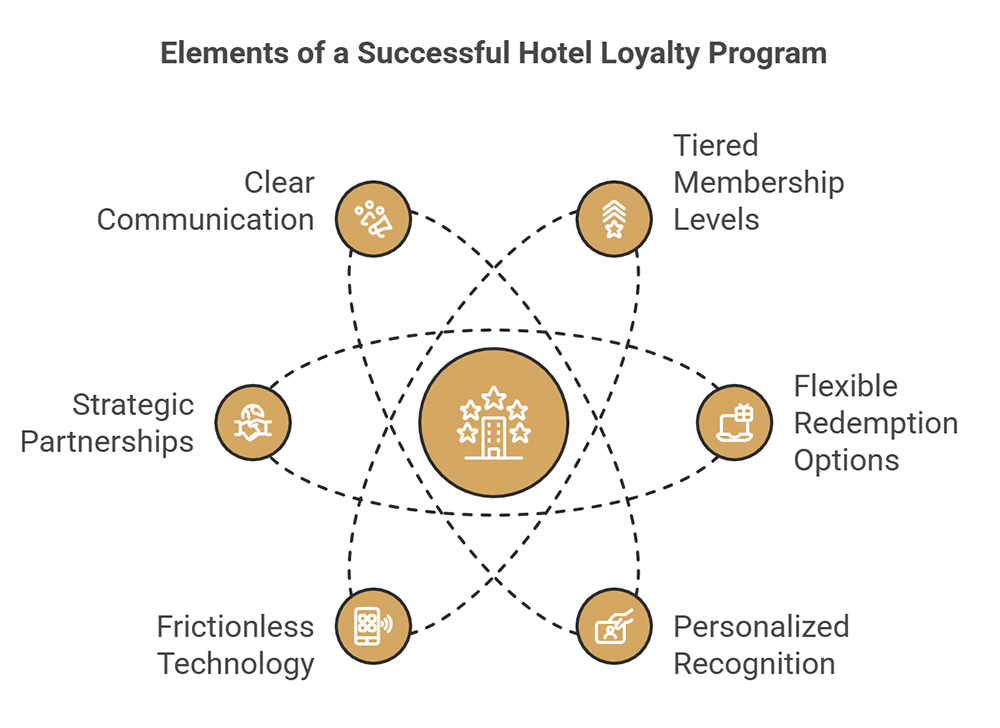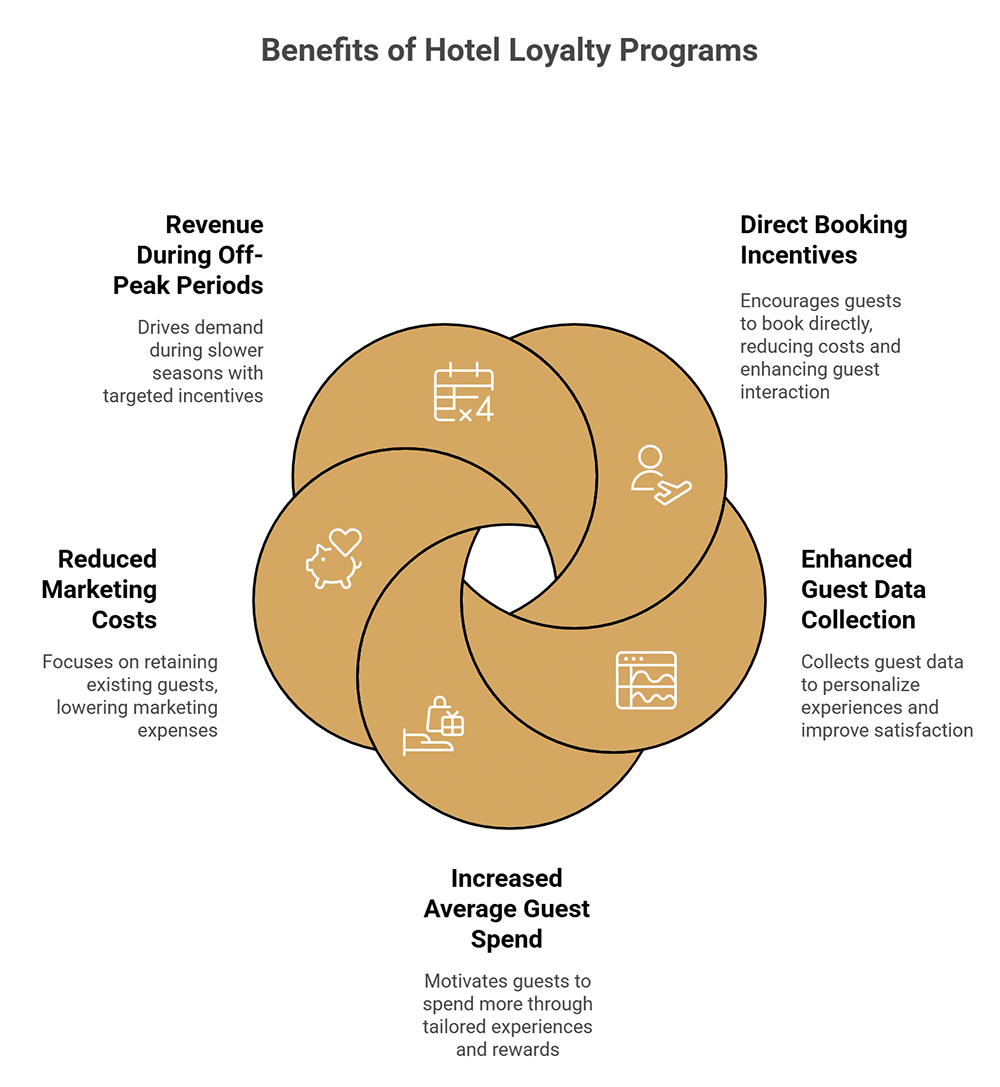Hotel loyalty programs provide guests with not just benefits and rewards but a tailored experience that fits like a glove. Properties leverage these programs to build up both brand and loyalty among guests to ensure return visits. The fact that both parties benefit makes loyalty programs one of the best tools a property has to compete within an often turbulent market.
In this article, you’ll discover not only the fundamental elements of the programs but also how to optimize them best.
Table of Contents:
- What is a Hotel Loyalty Program?
- Why Hotel Loyalty Programs Are Important for Your Property?
- Key Factors for a Successful Hotel Loyalty Program
- 10 Best Hotel Loyalty Programs to Grow Guest Retention
- Perks of Implementing Hotel Loyalty Programs
- Strategies to Create the Perfect Hotel Customer Loyalty Program
- Tips for Inspiring and Maintaining B2C Guest Loyalty in Hospitality
- 7 Tips to Attract More Corporate Travelers to Your Hotel
What is a Hotel Loyalty Program?
Hotel loyalty programs are membership-based programs that give guests additional reasons to come back and stick with a hotel brand. The programs track a number of metrics, but the most significant are night stays and spending. Points earned from those activities can then be redeemed for various rewards. The more a guest frequents a hotel, the more incentives they have to keep doing so.
However, membership also provides additional functions such as allowing check-in through mobile devices, specially tailored recommendations, and integration with travel-related services. The reach of hotel membership programs is wide enough that most travelers consider it a necessity. One program can impact the entire trip. In fact, the majority of serious travelers emphasize rewards when choosing their lodging, at 78%, according to a 2023 Oracle Hospitality survey.
Video: Ranking Hotel Loyalty Programs: Which One is Best for You
Why Hotel Loyalty Programs Are Important for Your Property?
Hotel loyalty programs aren’t just important to guests. They’re a vital tool for property owners as well. The reason is right there in the name – hotel guest loyalty programs promote loyalty. It’s a connection between the property and the guest that both parties can rely on.
When guests are certain that a property can meet and even exceed their needs, they’re not going to book through third-party sites. Direct booking makes it easier for guests and more profitable for hotels. Data shows that loyal guests using these services book more frequently and spend more during those stays. Properties can also use information from these programs to refine and expand their services to stay on top of a competitive market. The article “Loyal Guests: Unlocking Revenue with Loyalty Programs and Ancillaries” provides more insights about how loyalty programs can drive revenue for your property.
Key Factors for a Successful Hotel Loyalty Program
Successful hotel loyalty programs need to be carefully designed to balance value, engagement, and cost. Give special attention to the following vital elements:
- Tiered Membership Levels: Make status tiers with instantly appealing benefits that motivate guests to take action.
- Flexible Redemption Options: Spa, airport, and dining benefits can take hotel loyalty programs beyond rooms and into a guest’s life.
- Personalized Recognition: Ensure staff can recognize and acknowledge program membership to leverage guest preferences, show appreciation, and create lasting memories.
- Frictionless Technology: Cultivate appealing apps that make it easy for guests to enroll, track their points, and redeem benefits.
- Strategic Partnerships: Travel-related services like car rentals, local tourist spots, and airlines are often eager to join in on hotel rewards programs as guest-friendly practices are mutually beneficial.
- Clear Communication: Ensure your rules for earning and redeeming points are clear, with straightforward updates about points, benefits, and status to engage guests.
10 Best Hotel Loyalty Programs to Grow Guest Retention
One of the best ways to learn about the various benefits of hotel loyalty programs is to see them in action. The following are among the most exceptional examples of the practice:
1. World of Hyatt
World of Hyatt is especially notable for its easy-to-reach goals. Even casual travelers can reach elite status, and points are applied quite generously through a number of different systems. Affiliated spas, dining, credit cards, and airline services can all provide points. Rewards include room upgrades, exclusive experiences, and late checkout guarantees. The most important element to remember is that World of Hyatt shows how the quality of rewards can outshine quantity when making real connections and driving repeat bookings. If you want to find more information about the World of Hyatt loyalty program, read “Hyatt Hotel Brands: Learn About All the Hyatt Brands.”
Video: World of Hyatt | The Best Loyalty Program
2. IHG One Rewards
IHG One Rewards combines flexibility with scope. The program encompasses over 6,000 hotels all over the world. Likewise, these accommodations show tremendous range and include everything from budget options to luxury suites. IHG One Rewards also highlights the importance of tiered milestones to hotel loyalty programs. Guests can use a mobile app to handle point management, booking, and check-in. The seamless integration of a mobile app works alongside the program’s balance of long-term benefits with instant gratification. The system is easy to use and provides continual motivation to keep doing so. You can find detailed information about IHG One Rewards in the article “IHG Hotel Brands: List of InterContinental Hotels Group Brands.“
Video: A Complete Guide to The IHG One Rewards Program
3. Marriott Bonvoy
Marriott Bonvoy is an exceptional example of how divergent programs can be merged to create a powerful new whole. Marriott Bonvoy provides redemptions that cover over thirty brands, thanks in part to its convergence of legacy programs. On top of these partnerships, members will also enjoy accommodation-related options like late checkout, room upgrades, and lounge access. Marriott Bonvoy is also a notable example of the importance of customer appreciation. Members receive appreciation events and exclusives, which build trust and loyalty. If you want to find more information about the Marriott Bonvoy Program, read “Marriott Hotel Brands: Exploring the Brands of Marriott International.”
Video: How to Start Maximizing Your Marriott Bonvoy Points
4. Hilton Honors
Hilton Honors has leveraged technological innovation to achieve some outstanding results. For example, the hotel loyalty programs let guests digitally select and access rooms through electronic key access. In doing so, Hilton is able to gather even more information about the users’ preferences. It also provides a high level of flexibility in giving people options to top off their points with cash or share with family members. The program is made even more appealing through status matching. The program recruits people from competing services by giving them a similar status tier within Hilton Honors. You can find more information about Hilton Honors in the article “Hilton Hotel Brands: Learn About the Biggest Hilton Brands.”
Video: Hilton Honors Loyalty Program Brief Overview
5. Wyndham Rewards
Wyndham Rewards relies on straightforward and easy-to-understand mechanics. For example, its “go free” nights use a flat-rate redemption, which pushes past the complexity often seen in competing hotel loyalty programs. The same goes for the tier system, which makes it easier for casual travelers to reach the elite tier. The biggest draw of this program is simplicity, which has proven to be quite appealing.
Video: Wyndham Rewards Program for Everyone
6. Best Western Rewards
Best Western Rewards serves as an example of how to compete with larger brands. While it’s a mid-scale hotel chain, it’s been able to push ahead through hotel loyalty programs focused on personal attention to members. Guests enjoy generous policies such as points with no expiration date, easily reached tiers, and achievable rewards with no blackout dates. Best Western rounds out its system with seasonal promotions that address expected occupancy issues. Finally, the program provides negotiated services and rates for business travel.
Video: Best Western Rewards – An Award-Winning Loyalty Program
7. Accor Live Limitless (ALL)
The ALL program from Accor helps to break through brand confusion by integrating multiple hotels into a single loyalty program. In doing so, it unites the full range of economic options into a single, recognizable element. This all-encompassing approach extends to the point system as well. Members will find that entertainment, dining, and even many sporting events fall under the ALL program’s banner. Points earned through various sources, whether from staying at a hotel or spending with partners, allow for status qualifications. The ALL program highlights the importance of partnerships.
Video: Accor Hotels Loyalty Program: Stay for Free Worldwide!
8. Choice Privileges
Choice Privileges shows that corporate hotel loyalty programs can perfectly match the needs of spending-conscious business travelers. The program emphasizes the overall return on spending through high-point earning and special promotions. This balance ensures a consistently high-quality experience combined with extensive options and scope. On top of that, Choice Privileges provides a high level of digital integration for seamless guest experiences.
9. Radisson Rewards
Radisson Rewards combines a wide global scope with specialized attention to regional markets. This attention to detail also extends to the various demographics it serves. Business travelers will be able to enjoy corporate-style benefits that meet their specialized needs. While more casual travelers will find benefits tailored for them as well. It also provides a tier system that’s distinct among hotel loyalty programs for its strong differentiation. There are solid and easily understood benefits to climbing the tiers, which will motivate guests. While even mid-tier levels still provide impressive benefits, like room upgrades.
Video: Radisson Rewards – Bookers and Planners Benefits
10. Sonesta Travel Pass
Sonesta Travel Pass provides a solid example of how a newer program can compete with the existing hotel loyalty programs through more dynamic strategies. The program’s earning rate makes it much easier to obtain higher status tiers than most of its competitors. The key principle for this brand has been growth. Sonesta Travel Pass has been leveraging strategic, careful acquisitions to increase its reach. However, at the same time, the service has remained dependable and consistent at every point. The program also lures new members by letting them carry over their existing tier status from competing programs. A combination of careful growth, strong acquisition tools, and aggressive earning rates proves that newcomers can compete with established brands.
Video: Rewards Season | Sonesta International Hotels
Perks of Implementing Hotel Loyalty Programs
Hotel loyalty programs are especially impressive for the number of benefits they provide to guests and property owners alike. However, the following are the most significant:
Direct Booking Incentives
Hotel loyalty programs motivate guests to bypass third-party booking services. In doing so, a property will reduce commission costs and increase interactions with guests. This serves to build additional loyalty, build positive memories, and provide guest data. Third parties like travel agencies typically restrict that information, which is a valuable resource for personalized marketing. Knowing what guests want and what experiences they’re looking for can help a property in several ways. Likewise, a guest benefits from more personalized experiences, exclusive rates, and potential room upgrades. If you want to learn strategies to drive direct bookings, read “Top Tactics to Drive Direct Bookings at Your Hotel.”
Enhanced Guest Data Collection
Reward programs aren’t just about points. They aim to ensure return visits and improve guests’ loyalty. Hotel frequent guest programs leverage guest data such as what amenities are used, spending patterns, and room preferences. This will, in turn, let you create the optimal experience for that guest. The guest will feel appreciated and comfortable, and will have additional reasons to return. A property can predict guests’ needs, provide customized offers, and even communicate through their preferred channels. A 2024 McKinsey & Company hospitality report showed that leveraging data in this manner results in a 20% increase in guest satisfaction along with a 23% increase in spending.
Increased Average Guest Spend
Loyalty programs make guests feel appreciated and provide them with an experience tailored to their needs. This is one of the reasons why hotel reward schemes typically result in greater spending among guests. People who feel relaxed and valued will often treat themselves to spas, restaurants, and other options tied to the hotel’s revenue stream. The ever-present goals represented by points can also serve as a powerful motivator to increase guest spending. People close to a goal will want to spend more in order to reach it.
Reduced Marketing Costs
Building new relationships with potential guests is costly when compared to retaining your existing base. It’s estimated that guest retention is five to seven times more cost-effective than acquiring new guests. Hotel loyalty programs focus on a more profitable strategy of maintaining your base, which reduces the cost of marketing. Loyalty programs reduce marketing expenditures even more thanks to their direct communication channels. Everyone you communicate with through a loyalty program has a good chance of being interested. White-label hotel loyalty programs further streamline costs by providing the basic infrastructure of a plan that simply needs additional personalization. If you want to find more information about marketing expenditures, read our article “Evaluating the Cost of Acquisition in Hotel Marketing Strategies.“
Video: The Cost of Hotel Guest Loyalty Programs | Hotel Marketing
Revenue During Off-Peak Periods
Most hotels struggle with seasonal fluctuations. However, hotel reward options can help to even out the sharp rises and falls by influencing demand. You can use hotel loyalty programs to add additional incentives that will drive demand during slower seasons. Exclusive deals, multipliers only available during particular windows, reduced requirements for point redemption, and more can make a significant impact. The targeted nature of loyalty programs also makes them more financially effective than trying a broader public rate reduction.
Strategies to Create the Perfect Hotel Customer Loyalty Program
Hotel points programs are amazing tools, but they require careful attention to strategy and cultivation. Keep the following points in mind to ensure your success:
- Comprehensive Market Research: Use data from both your guests and from observation of competitors to create alluring rewards that exceed expectations.
- Realistic Financial Modeling: Consider your projected gain in revenue and compare it to the investments, including staff, which will go into the rewards.
- Staff Training Programs: Design and implement onboarding to not only train staff on the loyalty program but also to ensure they can explain its importance to guests.
- Phased Rollout Approach: Before a full implementation, consider trying a partial rollout with limited features to test and receive feedback.
- Data Integration Planning: Verify that any hotel membership solutions for businesses can be fully integrated into your existing point-of-sale and property management software.
- Measurement Framework: Create KPIs that will encompass program use metrics, enrollment, and total impact on revenue that can be regularly reviewed to refine your strategy.
Video: How to Get the Best Hotel Loyalty Programs & Win Your Customers?
Tips for Inspiring and Maintaining B2C Guest Loyalty in Hospitality
Hospitality loyalty solutions provide properties with a wealth of data that can be leveraged for dynamic strategies. This includes establishing B2C practices that will increase rates of direct bookings. You can discover how to identify and cultivate relationships with high-value demographics in the article “Tips for Inspiring and Maintaining B2C Guest Loyalty in Hospitality.“
7 Tips to Attract More Corporate Travelers to Your Hotel
Corporate travel requires some extra considerations, as do hotel rewards programs for business travel agencies. To appeal to this segment, you’ll want to hone specific strategies. You’ll learn how to target this market with special booking tools, billing systems, and rewards that still maintain universal appeal in the article “7 Tips to Attract More Corporate Travelers to Your Hotel.”
Hotel loyalty programs are powerful tools. However, they’re ultimately built on a foundation of trust between guests and the property. This relationship creates competitive advantages, profit, and a great experience for guests.
Did You Like This Article about the Best Hotel Loyalty Programs?
You might also be interested in the following articles:
- 10 Best Hotel Booking Apps to Maximize Revenue and Visibility
- How can Hotels Balance their use of OTAs Vs Direct Booking Channels?
- AI Agents Are Now Booking Hotel Rooms – Is Your Property Ready?
More Tips to Grow Your Business
Revfine.com is the leading knowledge platform for the hospitality and travel industry. Professionals use our insights, strategies, and actionable tips to get inspired, optimize revenue, innovate processes, and improve customer experience.Explore expert advice on management, marketing, revenue management, operations, software, and technology in our dedicated Hotel, Hospitality, and Travel & Tourism categories.










Leave A Comment